Lifestyle
Rijeka: Croatia’s coastal gem, rich in history, hidden wonders
Rijeka, meaning “river” in Croatian, is a captivating port city on the Adriatic coast, inviting you on a journey through time with its rich history and multicultural tapestry. As Croatia’s third-largest city and home to its most significant port, Rijeka has been a coveted prize throughout history, bearing the marks of various communities, including Italian, Hungarian and Croatian cultures and even experiencing Ottoman incursions.
Today, Rijeka is the largest port in the Kvarner Bay, an inlet of the Adriatic Sea, just two hours from Croatia’s capital, Zagreb. With its historical significance, stunning architecture and strategic location, Rijeka promises an unforgettable experience for anyone visiting Croatia.
Architectural marvels
Capuchin Church of Our Lady of Lourdes: Upon entering the city, you’ll be greeted by the neo-Gothic Capuchin Church, built in the early 1900s. Legend has it that the upper floor of the church remained unfinished due to financial difficulties. Funds were later collected in the name of a supposed saint, allowing for its completion. However, the truth was eventually revealed, leading to the “saint’s” prosecution for fraud.
Saint Vitus Cathedral: Construction of the Rijeka Cathedral, also known as Saint Vitus Cathedral, began in 1638 in the heart of old Rijeka. Taking over a century to complete, it was finally finished in 1744. This cathedral holds a dramatic history, including a cannonball embedded in its wall that ties into a local legend. During the Napoleonic Wars, a Croatian girl named Karolina bravely implored British soldiers to cease fire during an attack. Her beauty so moved the British officers that they halted their assault, saving many lives. You’ll find Karolina’s name echoed throughout the city, a testament to this heroic tale. Housing numerous Baroque artworks, the cathedral is truly at the heart of the city.
Church of St. Nicholas: As you turn toward the port, you’ll encounter an Orthodox church that embodies Balkan resilience. In stark contrast to the city’s opulent buildings, the simple St. Nicholas Serbian Orthodox Church has an intriguing story. Serbs, who once constituted a significant portion of the city’s population, persistently demanded a church. Exasperated by their insistence, the governor reportedly threw a stone into the sea and challenged them, “Go on, build your church here!” Embodying the notorious Balkan stubbornness, the Serbs filled the coastline and built their church precisely on that spot.
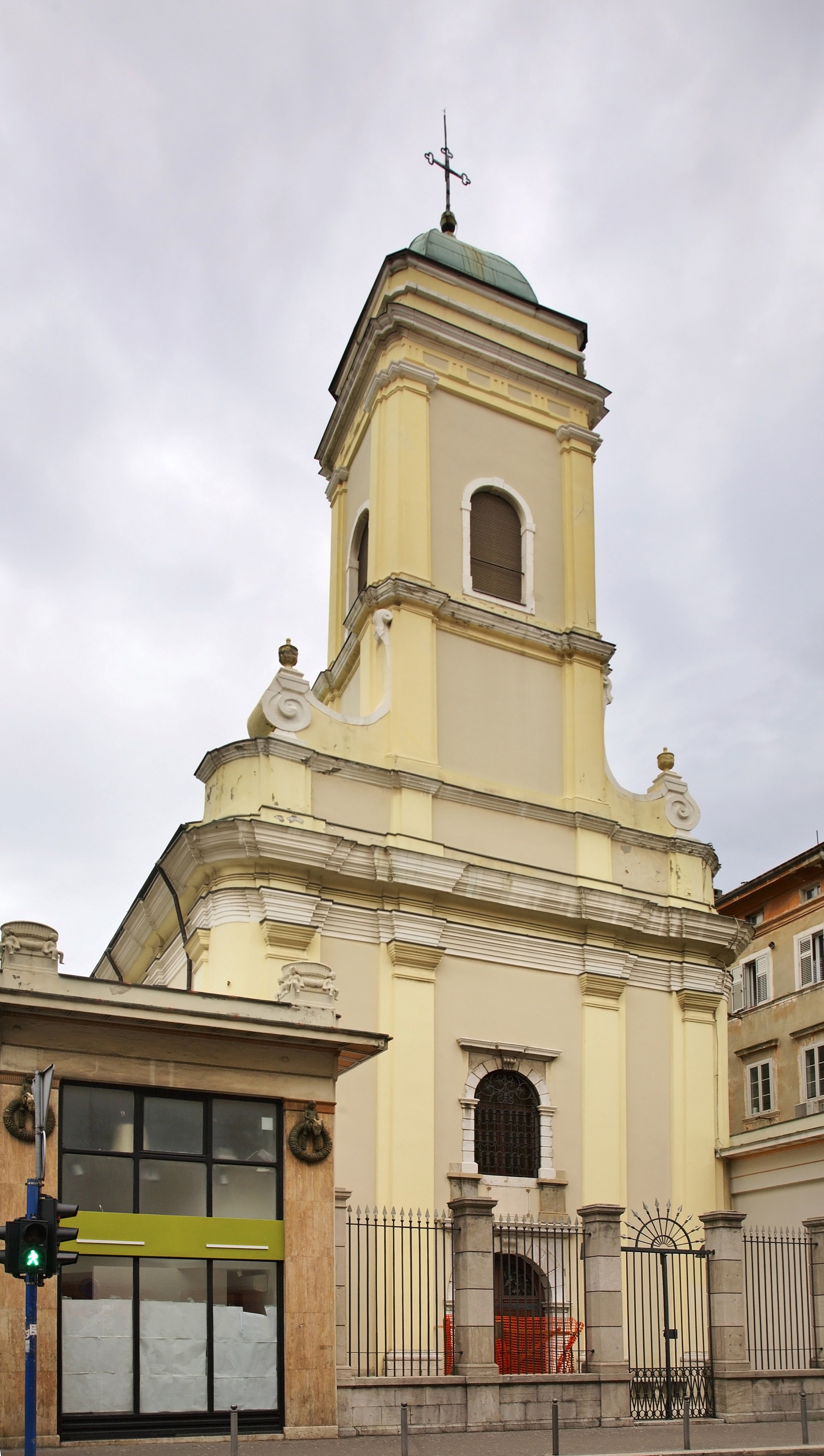
Gradski Toranj (City Tower): Walking along Rijeka’s famous Korzo Street, you’ll come across this yellow clock tower, a prominent symbol of the city. Uniquely positioned amid other buildings, it is a gateway to Ivan Kobler Square. This tower, a passage to ancient Roman ruins, is truly worth seeing and photographing.
Cultural hubs
Computer Museum Peek & Poke: Computer Museum Peek & Poke boasts a fascinating two-story computer museum that promises an unforgettable experience. Here, you’ll find a collection of historic computers, printers and gaming consoles. It’s a particularly engaging stop for families with children, offering insights into the evolution of technology.
Historic National Theater: Beyond its identity as a port city, Rijeka emerges as a significant historical and cultural center of Croatia. The historic theater building, home to exciting shows and stage performances, is arguably one of the city’s most architecturally stunning and must-see structures. You might even catch a magnificent performance during your visit. The Croatian National Theatre Building, built in a magnificent Baroque style by Austrian architects Fellner and Helmer, opened in 1885 and was notably one of the first places in Europe to use electric light bulbs.
Urban exploration
Korzo Street, the bustling main shopping street and the beating heart of Rijeka, is also home to wonderful cafes and restaurants offering delightful culinary experiences. Strolling along this historic cobblestone street, you’ll soak in the vibrant atmosphere of the city.
Rijeka’s Ornate Buildings: The ornate and colorful buildings, showcasing the Balkans’ love for grandeur, certainly deserve a spot on the list of famous landmarks. The Ploech Building, adorned with intricate sculptures and the Modello Palace (Palača Modello), an architectural masterpiece by Austrian architects located across from Kazalisni Park, are just a couple of the magnificent structures perfect for a photo opportunity.
Looking up from the confluence of the canal and the river, you’ll spot Trsat Castle perched on a hill, another worthy addition to your itinerary. Inside the castle, you can enjoy your time exploring St. Mary’s Church with its important icons, the Franciscan Monastery, various parks, restaurants and cafes, an exhibition hall and sports fields.
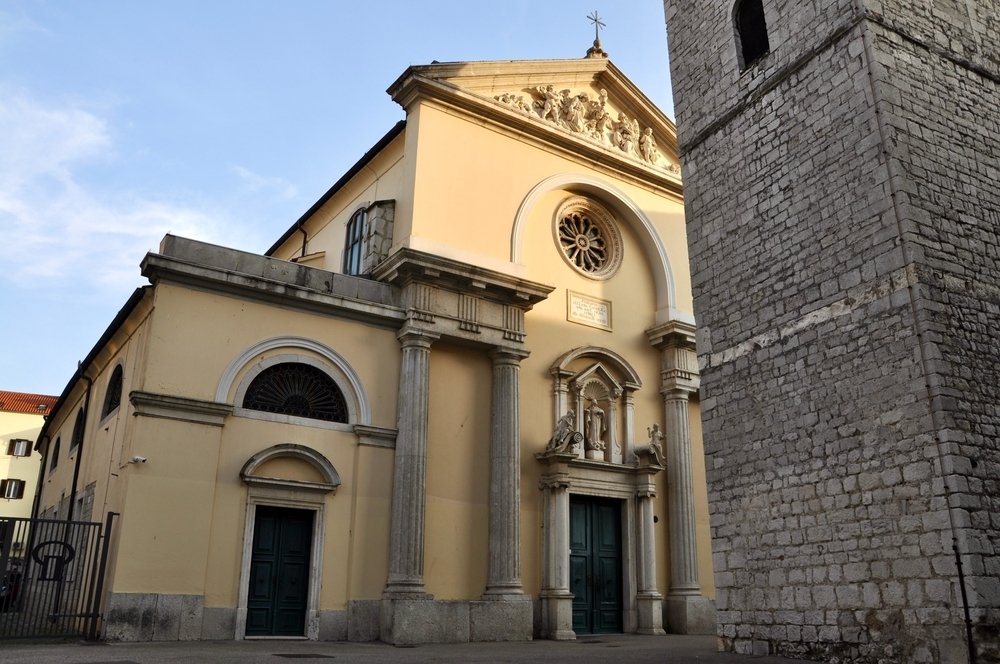
Walking along the canal will lead you to the square where the Church of the Assumption of the Blessed Virgin Mary and the Leaning Tower are located, allowing you to trace Rijeka’s historical footprints.
Rijeka’s beaches
Don’t forget that Rijeka offers numerous beaches close by where you can enjoy the summer sun.
Kantrida beach: Located about 3 kilometers (1.86 miles) southwest of the city center.
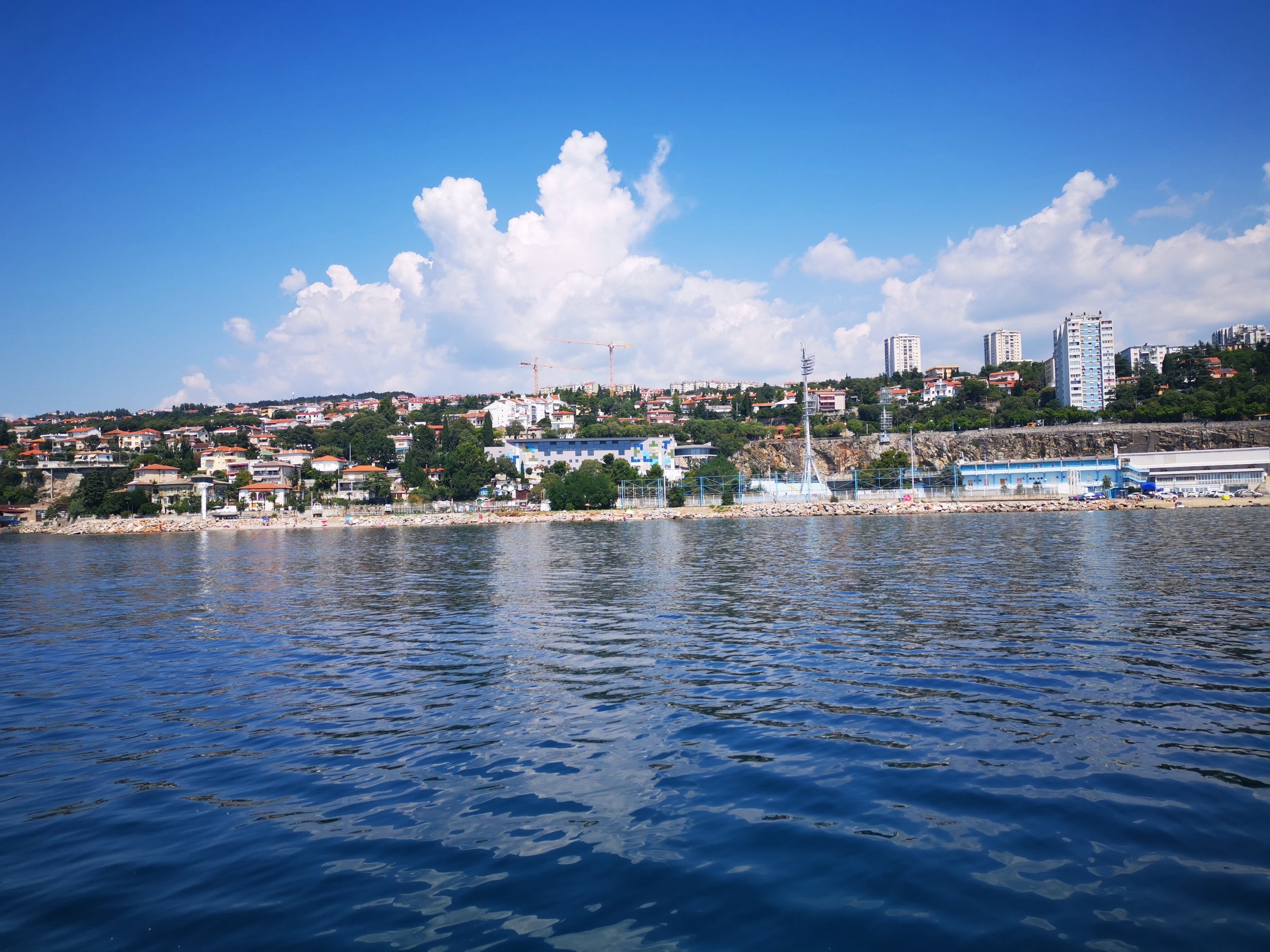
Sablicevo beach: Situated in Kvarner Bay, it is known for its fine pebbles and clean water.
Javna beach: While not ideal for families with children due to its high and steep rocky cliffs, it offers breathtaking sunsets.
Kostrena beach: Located northwest of Rijeka, it has been awarded the prestigious “Blue Flag” for its quality.
Ploce beach: A popular choice for families with children.
These are just a few excellent beaches where you can bask in the Adriatic’s refreshing waters.
In Rijeka, with every step, you’ll touch a different era and around every corner, you’ll encounter another culture. Start your mornings on Korzo Street with the aroma of fresh coffee, and in the evenings, listen to the whispers of the past as the sun sets in fiery hues by the sea.
Lifestyle
Türkiye’s Tekirdağ becomes floral tourism hot spot
Canola, lavender and sunflower fields in Tekirdağ, on the northern coast of the Marmara Sea, attracted thousands of tourists to the city throughout the season.
The fields located in the city center and districts became a focal point of interest for visitors from early May to mid-July.
Many people coming from nearby provinces captured the best photo shots of the decorations created within the canola, lavender and sunflower fields.
The lavender and sunflower fields, resembling natural studios, became a popular spot throughout the season, both for photography enthusiasts and those who wanted to spend time in nature.
Ömer Faruk Karaküçük, the provincial director of Culture and Tourism, told Anadolu Agency (AA) that the canola, lavender and sunflower fields in Tekirdağ added color to the city’s tourism.
Karaküçük stated that Tekirdağ is a city that draws attention not only with its historical and cultural richness but also with its natural beauty. “Especially the canola, lavender and sunflower fields attract thousands of visitors every year and captivate them. These colorful fields add both aesthetic and value to our city and make an important contribution to tourism,” he said.
He noted that photographers captured the beauty of the colorful fields through their lenses, and these images reached a wide audience via social media and digital platforms.
Karaküçük emphasized that the events organized in the canola, lavender and sunflower fields have given a significant boost to the city’s promotion. “These vast lands are not only used for agriculture but also attract great interest with their visually stunning landscapes. These beauties serve as a natural studio for photographers. Naturally, our citizens flock to these areas to take souvenir photos. Every day, hundreds and sometimes even thousands of people come to Tekirdağ to enjoy these unique scenes. The interest of both domestic and foreign tourists is growing steadily. These unique and colorful fields offered by nature have further strengthened Tekirdağ’s tourism power,” he added.
Lifestyle
Türkiye’s Mediterranean paradise: Tourism spot for nature lovers
Nestled in Antalya’s Kemer district, Türkiye’s Mediterranean gem has become a favorite destination for both local and international travelers seeking serenity, natural beauty and a slower pace of life. With its crystal-clear waters, golden sandy beach and peaceful atmosphere, Çıralı offers a unique blend of nature and culture tourism, drawing in visitors from around the world.
Often referred to as one of the hidden paradises of the Mediterranean, Çıralı is a place where time seems to stand still. Vacationers can stay in cozy bungalows or boutique hotels that are carefully integrated into the lush natural surroundings. Family-run guesthouses offer travelers a taste of genuine Turkish hospitality, while boat tours provide an opportunity to explore untouched coves and secluded bays.
According to Derya Yavuz, a local bungalow owner, tourism in the area is steadily picking up:
“The sea is exceptionally clean and the nature is simply breathtaking. We don’t just sell rooms here-we earn a living thanks to the nature around us. That’s why we do everything we can to protect it.”
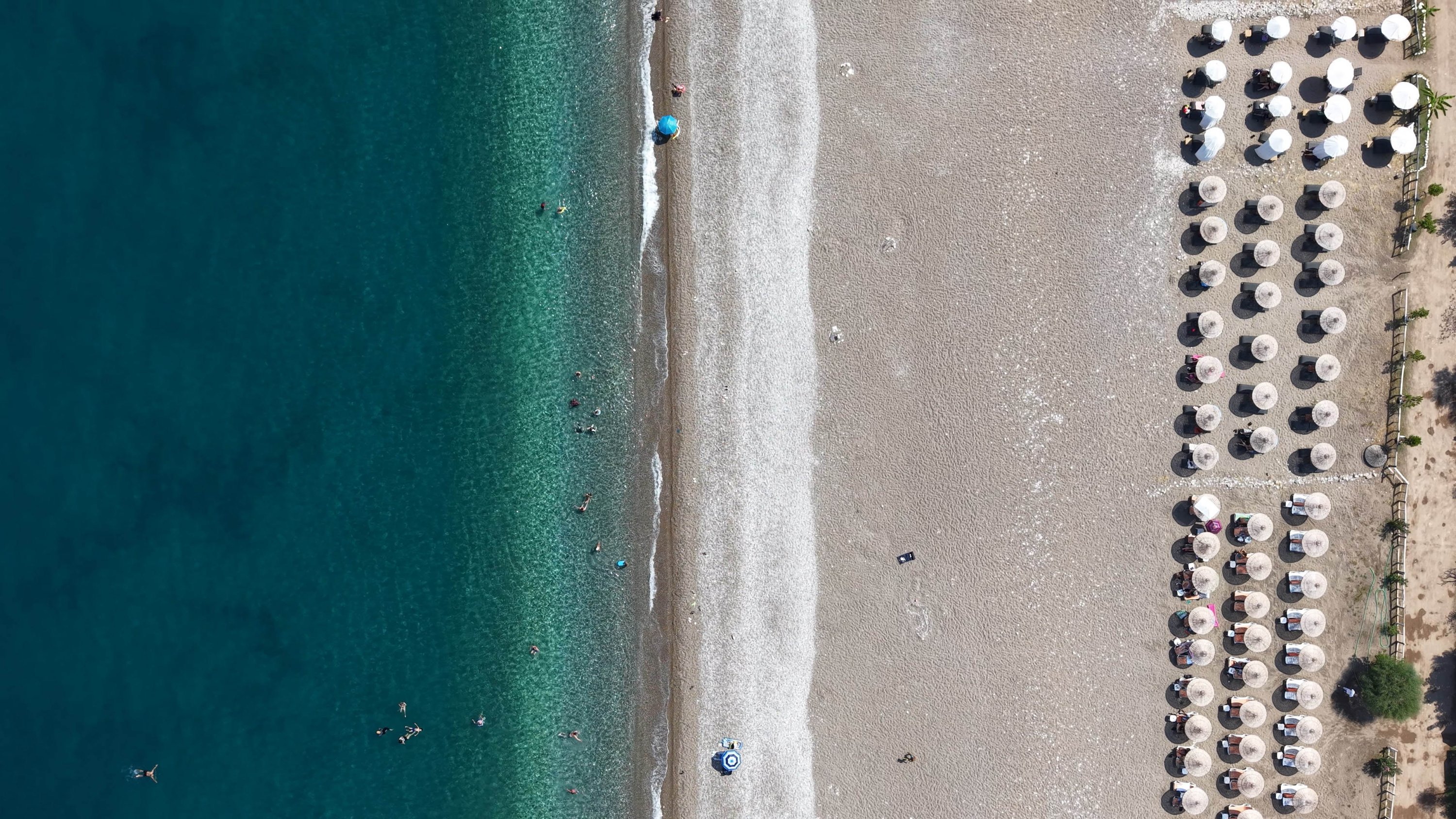
Çıralı is more than just a beach town. During spring and autumn, hikers flock to the area to walk sections of the famous Lycian Way, one of Türkiye’s most scenic trekking routes. Day trips to remote beaches, ancient ruins and charming coastal villages create an experience that’s both active and reflective.
But Çıralı is also a statement against mass tourism. Yavuz draws a clear line between Çıralı and the all-inclusive resorts found elsewhere along the Turkish Riviera:
“Unlike the big five-star hotels, we only offer bed-and-breakfast. I believe tourism should mean freedom. Here, guests can choose how they spend their day-maybe fresh fish at a seaside restaurant or traditional gözleme made by a local villager. It’s about experiencing real life, real food and real people.”
Perhaps what makes Çıralı so special is its commitment to preserving its natural and cultural integrity. There are no concrete high-rises here-just individual wooden bungalows scattered among trees. Each one is self-contained, featuring modern amenities such as private bathrooms, air conditioning, and refrigerators, while still completely immersed in nature.
“People come here to escape the city, to quiet their minds,” says Yavuz. “It’s also great for families-no traffic, no stress. Children are free to run to the sea and back, all day long.”
In Çıralı, green meets blue and every sunrise promises not just a beautiful day, but a deeper connection with the world around you.
Lifestyle
Side Ancient City’s nighttime glow captivates visitors in Türkiye
The Side Ancient City in Manavgat district of Antalya, located in Türkiye’s Mediterranean region and bearing traces from the Late Bronze Age, Hellenistic, Roman and Byzantine periods, now welcomes visitors after dark through the “Heritage for the Future Project.”
Situated in the ancient region of Pamphylia and historically one of the most important port cities, Side has been the focus of continuous archaeological excavations since 1947. These ongoing digs have uncovered priceless artifacts each year. Among the city’s treasures are the ancient temples of Athena and Apollo, dating back over 2,000 years, which still reflect the grandeur of their time.
As part of the Ministry of Culture and Tourism’s “Heritage for the Future Project,” the Side Ancient City has been beautifully illuminated, transforming the site into a mesmerizing spectacle after sunset. Nighttime visits have become popular among both local and international history enthusiasts, especially during the hot summer months when daytime temperatures can be overwhelming.
The majestic temples and historic ruins, bathed in light, offer visitors an unforgettable visual feast.
Ahmet Özden, board member and representative for the Mediterranean Region, told the Anadolu Agency (AA) that the Ministry’s project represents a significant investment in cultural tourism.
Özden emphasized that Side is a key ancient city within this initiative, noting that recent efforts have completely transformed the site’s appearance.
He explained that the city has begun to attract more tourists, especially in the peak months of June, July and August. “Due to high temperatures during the day, tourists visiting Antalya often find it difficult to explore ancient sites. They tend to avoid such excursions in the heat. But since the introduction of night visits starting at 5 or 6 p.m., Side has seen a lively buzz of activity,” Özden said.
He added that the lighting has given the ancient city a striking new look, with the Apollo Temple becoming a favorite spot for photography enthusiasts.
Tourism professionals have expressed satisfaction with the concept of the night museum. Özden shared: “We receive positive feedback from vacationers, which makes us happy. Nighttime visits have also contributed to a boost in the local economy. Previously, we mostly sold sun, sea and sand tourism; however, recent investments in cultural tourism have diversified the sector. There are travelers worldwide who prioritize history and culture and Türkiye is increasingly becoming a top destination for these tourists.”
He also noted that diversifying tourism has helped extend the travel season.
Visitor Gökay Demirel praised the night museum experience as highly beneficial. Citing the difficulty of exploring the site comfortably during scorching daytime heat, Demirel said: “In extreme heat, people prefer to stay indoors. Visiting the ancient city was less appealing before, but the illumination and ability to tour at night have delighted history lovers like us. We enjoy wandering the city and learning about its historical remains.
Lifestyle
National Geographic highlights magic of Cappadocia
The world-renowned media organization National Geographic has garnered international attention to the heart of Cappadocia, a popular tourist destination in central Türkiye, through a captivating video shared on its Instagram account, which boasts over 46 million followers.
The video, a visual celebration of the region, features everything from vibrant hot air balloons painting the skies to centuries-old rock-carved churches and offers viewers a breathtaking glimpse into Cappadocia’s otherworldly beauty.
But it’s not just about the visuals. The production also highlights efforts to preserve Cappadocia’s cultural and natural heritage, a message that resonated deeply with viewers and earned widespread praise across social media.
Cem Aslanbay, director of the Cappadocia Area Presidency, emphasized the importance of this global exposure, calling it a milestone for the region.
“Cappadocia is not merely a land that holds the traces of the past – it is a universal heritage to be passed on to the future. Being featured on such a prestigious platform as National Geographic gives us a unique opportunity to share this legacy with the world,” he explained.
Aslanbay also stressed that the significance of this feature goes beyond tourism. It serves as a critical moment for raising awareness around sustainability and cultural preservation.
“We view such international promotions not only as tourism invitations, but also as key opportunities to highlight the need for protecting our cultural heritage and ensuring its transmission to future generations,” he said.
In alignment with the strategic goals set by the Ministry of Culture and Tourism, the Cappadocia Area Presidency affirms that its promotional efforts will continue uninterrupted – striving to spotlight every corner of this extraordinary landscape.
Lifestyle
Nature lovers find refuge in Bosnia’s Blidinje Park, Dreznica River
With the arrival of summer, Blidinje Nature Park and the Dreznica River – two of Bosnia-Herzegovina’s hidden natural treasures – are emerging as top destinations for both domestic and international tourists.
Visitors seeking to escape the crowds are increasingly drawn to the serene landscapes of southern Bosnia-Herzegovina, where Blidinje and Dreznica offer pristine nature and tranquility.
Declared a nature park in 1995, Blidinje is nestled between the Cvrsnica and Vran mountains. It has become one of the country’s most visited spots thanks to its rich biodiversity and scenic surroundings.
The park is also home to Blidinje Lake, the largest mountain lake in Bosnia-Herzegovina. Its fresh air and unspoiled environment make it a popular summer retreat.
Among Blidinje’s key attractions are 150 medieval tombstones, known locally as “stecci.” These ancient stone monuments, designated as a National Monument of Bosnia-Herzegovina, offer visitors a glimpse into the region’s storied past.
Located near the towns of Jablanica and Mostar, the park attracts hiking enthusiasts, many of whom ascend Cvrsnica Mountain to reach Hajduk Gate –a natural rock formation that offers breathtaking views from the summit.
Turquoise waters
North of Mostar, the Dreznica River winds through dense forests and rugged cliffs, mesmerizing visitors with its turquoise waters and crystal-clear streams.
A tributary of the Neretva River, Dreznica has gained attention in recent years as one of the country’s hidden jewels. While long cherished by locals, it has become a favorite among tourists as well.
The river, which creates natural pools among the rocks, is often described as “magical” by those who visit. Nearby, travelers can also explore three waterfalls, each ranging from 10 to 12 meters (33 to 39 feet) in height.
Dreznica offers a peaceful setting, far from the noise and bustle of city life – a place where nature lovers can relax and reconnect with the outdoors. The area continues to attract a growing number of visitors each year.
As they explore southern Bosnia-Herzegovina, tourists are increasingly venturing beyond the well-known sites to discover the country’s lesser-known natural wonders.
Lifestyle
Planning Paros: Traveler’s guide to Greece’s chicest island escape
Located in the southeast of Greece, nestled among the Cyclades Islands, Paros is emerging as a true gem of the Aegean. As the third largest island in the Kyklades group, Paros is a harmonious blend of nature and elegance. Imagine beaches where every shade of blue dances in crystal clear waters, valleys blanketed with vineyards and olive groves, charming fishing villages and postcard-perfect white and pastel-hued houses. This is where simplicity meets sophistication.
You can reach Paros from Istanbul via a connecting flight through Athens with Turkish Airlines (THY) and its Star Alliance partners on one itinerary, or you can book your tickets separately: one for the Istanbul-Athens leg and another for the Athens-Paros flight.
Paros is well connected via a small domestic airport, linking effortlessly to Athens and Thessaloniki through reliable carriers like Aegean Airlines and Sky Express. The flight from Athens takes just 45 minutes, making it a quick escape. In high season, daily flights are frequent, but booking ahead is a smart move as seats tend to sell out fast.
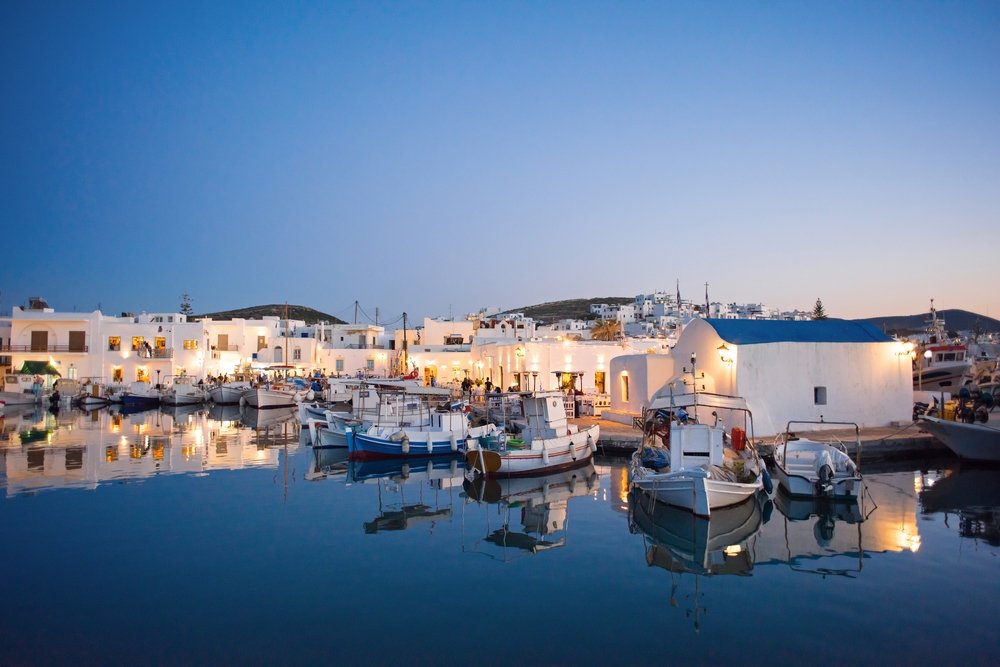
For a slower, scenic journey, ferries to Paros from Athens is a great option. Depending on the route, the ferry ride takes around three to 4.5 hours, offering a more relaxed introduction to the island’s magic.
Two souls of Paros
Paros offers something for every type of traveller. Whether you’re seeking a serene retreat, an active escape with diving and windsurfing, or a vibrant nightlife experience, Paros accommodates all moods effortlessly. The island revolves around two main hubs: Parikia, the main port and capital, and Naoussa, its lively and stylish northern village.
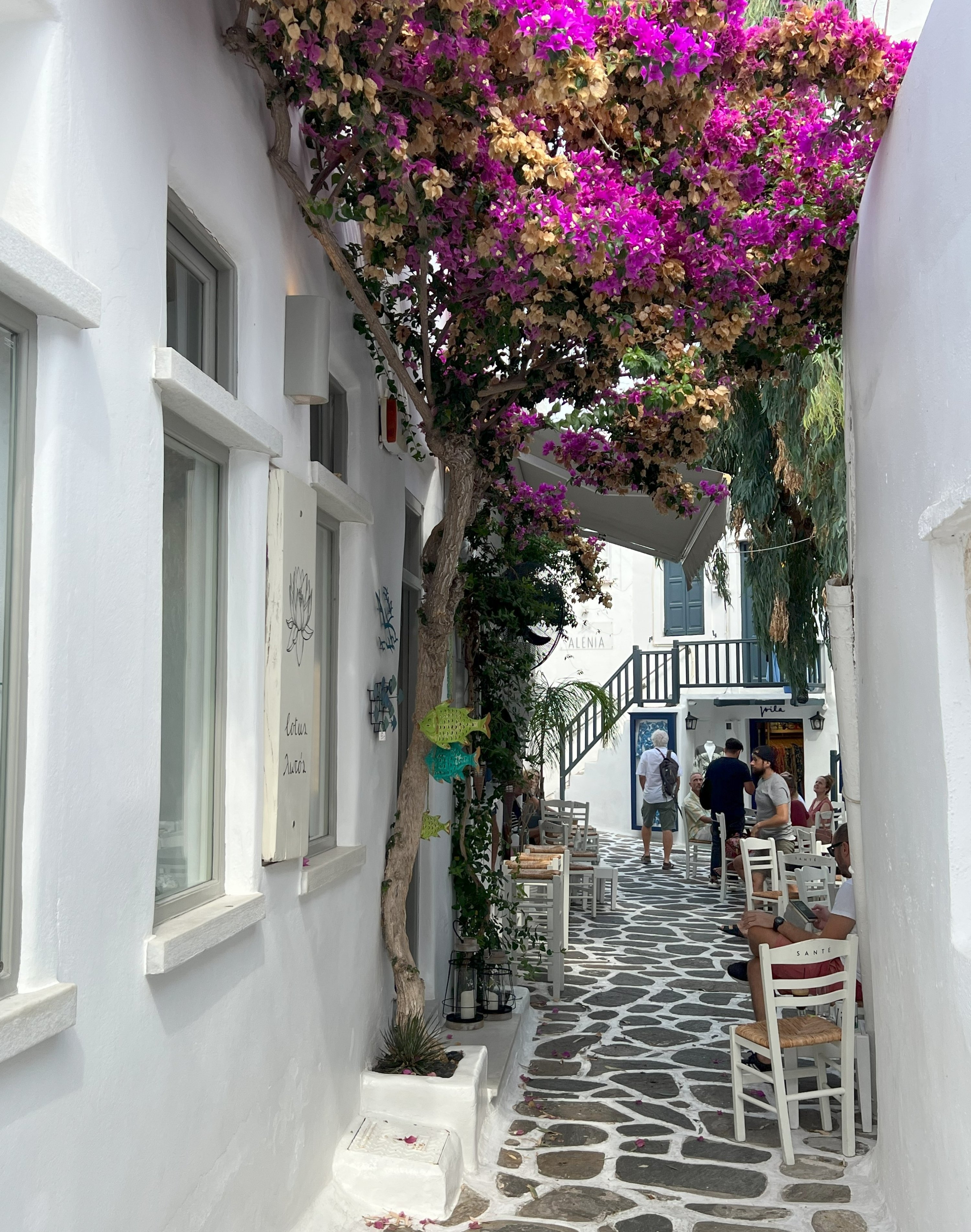
Step into Naoussa and you’re instantly transported to a Cycladic dream. With its whitewashed houses, cobblestone alleys, blue-domed churches and a harbour that glows with life, Naoussa exudes timeless Greek charm. At the port, you’ll often see freshly caught octopus hanging in the sun, while the nearby Venetian castle offers sweeping views over the village, framed by bougainvillea-covered houses and the endless Aegean. Don’t miss a walk up to Faneromeni (Panagía) Church perched on a hill, it’s the perfect sunset viewpoint with breathtaking panoramic views.
Parikia, on the other hand, is the island’s beating heart. With its traditional Cycladic architecture, picturesque promenade, golden sunsets and lively town square, it offers the perfect balance of energy and relaxation. This is where most ferries arrive, making it the practical entry point to Paros and a vibrant base for exploring the island.
At its center lies the historic Ekatontapiliani Church, the “Church of a Hundred Doors,” a Byzantine masterpiece dating back to early Christianity. Meander through Parikia’s labyrinthine streets, filled with charming shops, inviting cafes and buzzing tavernas. Nearby, several beautiful pebble sand beaches offer plenty of swimming options, while the hilltop castle built in 1260 by Duke Sanoudos adds a touch of history. Today, Parikia is home to around 5,000 year-round residents and remains the cultural and historical soul of the island.
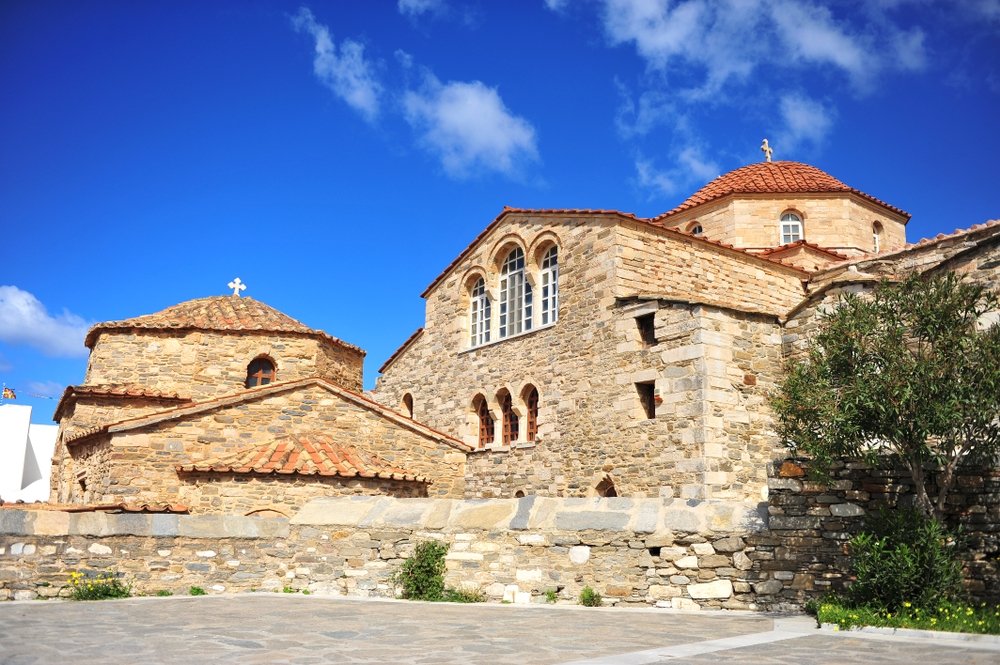
Parocks Hotel & Spa
A beacon of elegance among Paros’s luxury offerings, Parocks Hotel & Spa is a five-star boutique escape with just 40 rooms and suites, making it an ideal sanctuary for couples and honeymooners. Nineteen of the rooms boast private Jacuzzis, while 13 feature private pools. The eight spacious suites take it a step further, offering fully private plunge pools.
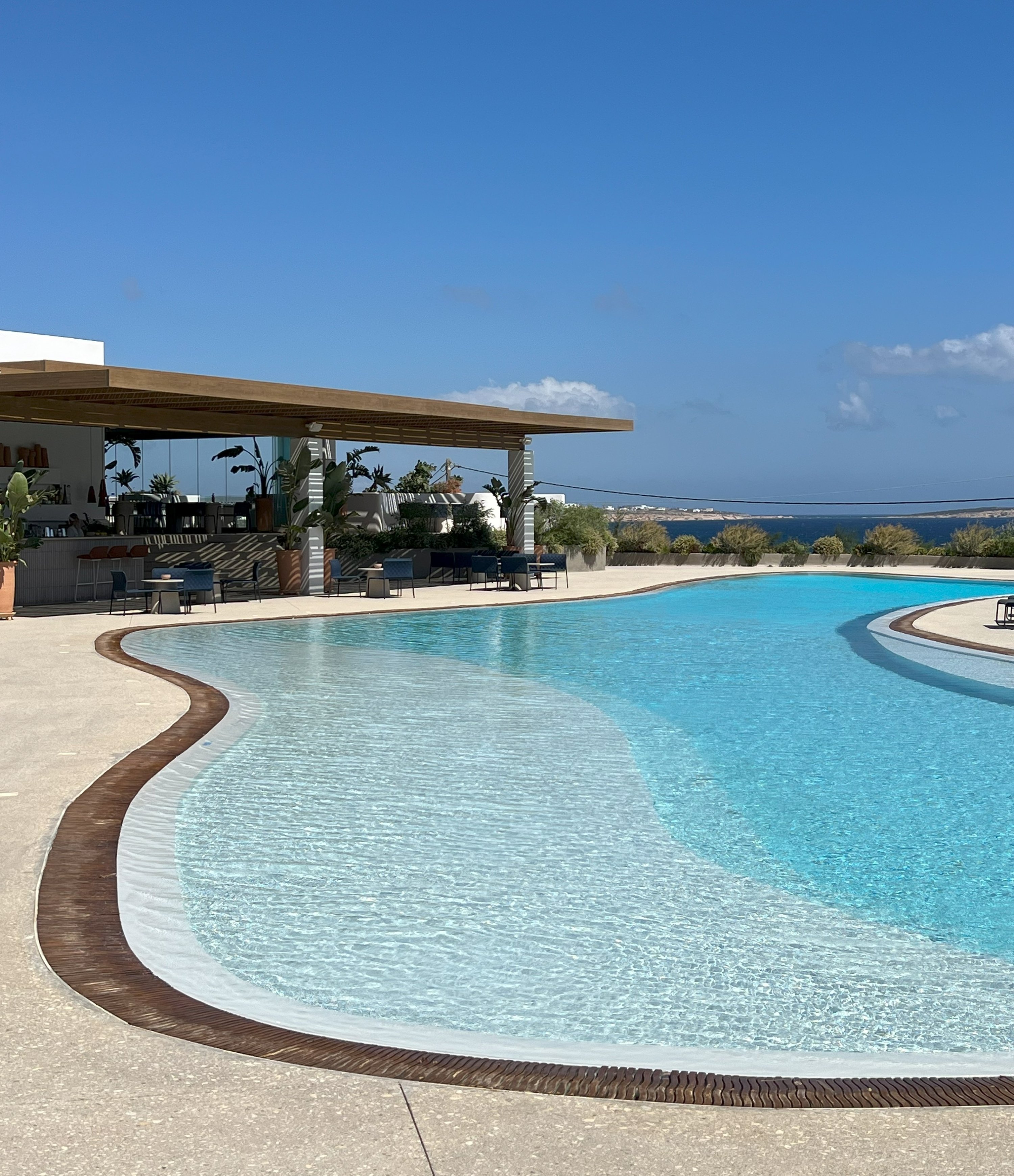
The heart of the hotel is its stunning restaurant and poolside bar the perfect spot to watch the sun dip into the sea while sipping a signature cocktail. Just 5 kilometers (3.11 miles) from Naoussa, Parocks is nestled in a peaceful corner of the island, yet close enough to the action. With its minimalist design and focus on tranquillity, it offers the perfect retreat for those seeking seclusion with a touch of indulgence.
For those wanting to explore more freely, renting a car or scooter is highly recommended. Paros is dotted with idyllic beaches and scenic coastal drives and given the limited number of taxis, having your own transport is a major plus. Parocks Hotel is located about 22 kilometers from Paros National Airport.
Andronis Minois Hotel
A newcomer to the island’s luxury hotel scene, Andronis Minois opened its doors in 2023 and is already making waves. With 44 suites and rooms, the hotel is part of the prestigious Small Luxury Hotels (SLH) collection. Located just five minutes from the airport and 10 minutes from Parikia, it offers both convenience and seclusion.
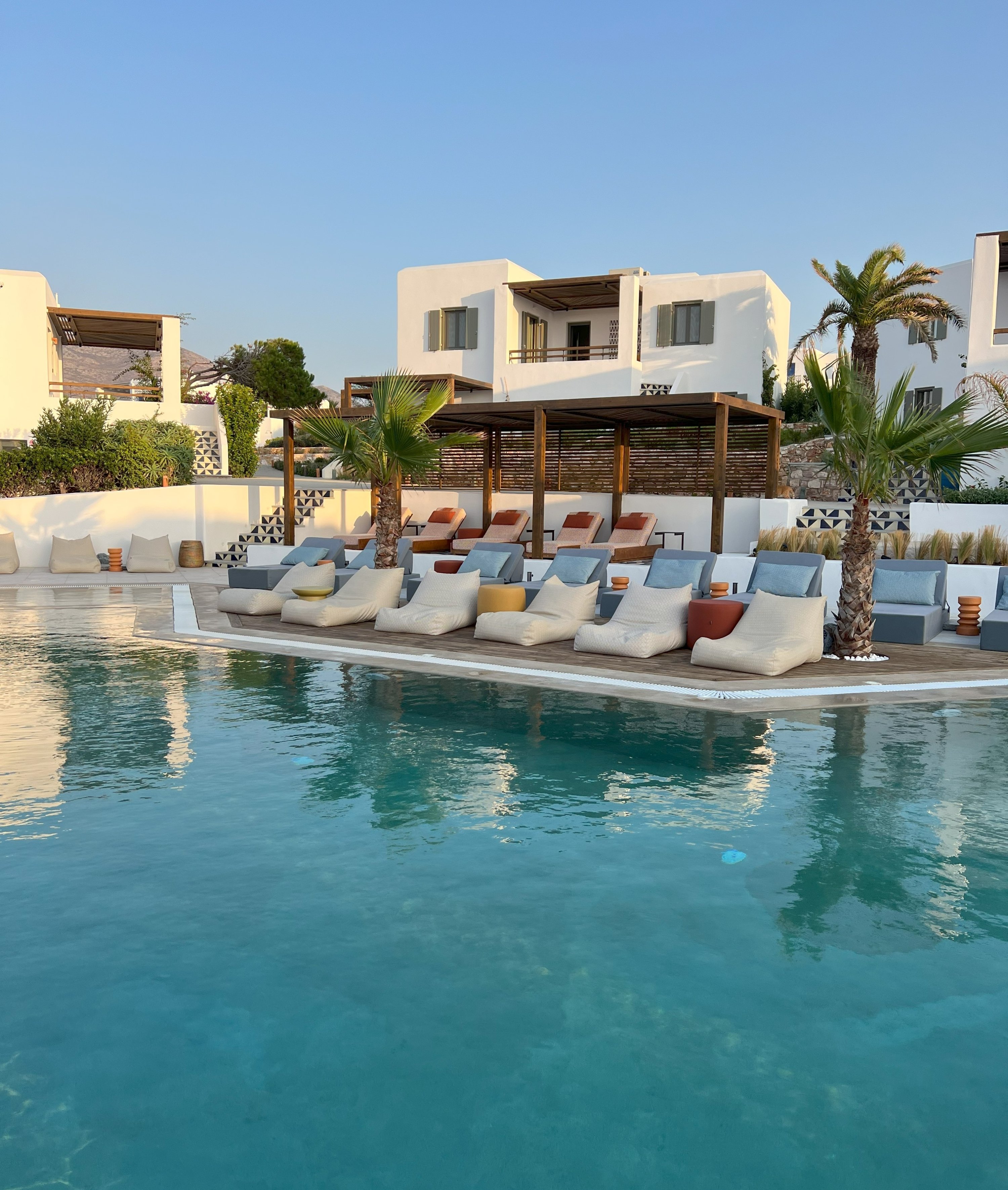
Perched on rocky cliffs near the 300-meter-long (984.25-foot-long) Parasporos Beach, the hotel offers quick access to several other beaches on the island. Rooms come with private balconies or terraces and select suites feature expansive pools and panoramic sea views.
The in-house restaurant, OLVO, is helmed by chef Tsantilas. Expect an exceptional culinary journey blending refined Greek Flavors with contemporary flair. Be sure to book a table for dinner, as the sunset here is a visual not to miss and the food is a gastronomic feast.
What makes Andronis Minois especially memorable is its warm hospitality and relaxed ambiance, it feels less like a hotel and more like your home away from home.
-
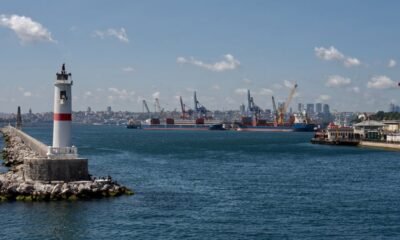
 Economy3 days ago
Economy3 days agoTürkiye sees exports to Africa near $10B in 1st half of 2025
-
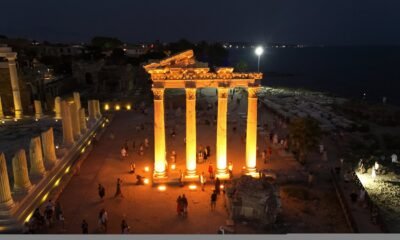
 Lifestyle23 hours ago
Lifestyle23 hours agoSide Ancient City’s nighttime glow captivates visitors in Türkiye
-

 Daily Agenda3 days ago
Daily Agenda3 days agoLast minute | Historical moments in the defense industry: 48 signatures were signed for the sale of Kaan
-
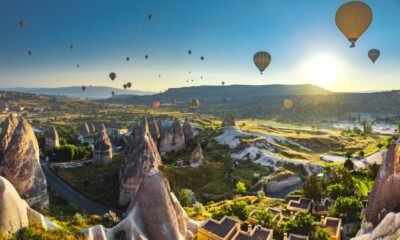
 Lifestyle1 day ago
Lifestyle1 day agoNational Geographic highlights magic of Cappadocia
-

 Economy22 hours ago
Economy22 hours agoOrban slams US deal, says Trump ‘ate’ EU chief ‘for breakfast’
-

 Lifestyle21 hours ago
Lifestyle21 hours agoTürkiye’s Mediterranean paradise: Tourism spot for nature lovers
-

 Refugees1 day ago
Refugees1 day ago2 volunteers die fighting Turkey wildfires, raising deaths to 17 since late June
-

 Economy19 hours ago
Economy19 hours agoFrench PM Bayrou calls US trade deal ‘dark day for Europe’




